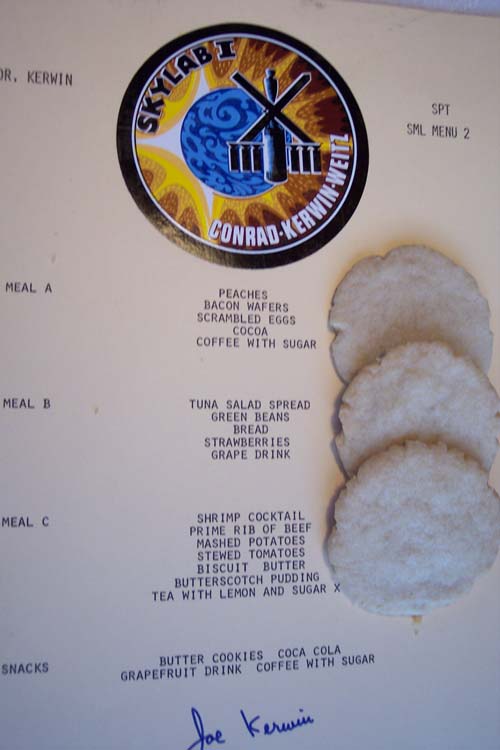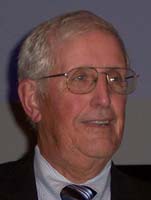Report
by Charles Bourland
- Published: Monday, April 08 2013 19:53
For GAM 2013, Dr. Charles Bourland - author of the book “The Astronaut’s Cookbook” - will share recipes throughout the month. We invite you to try them and share your images via our Facebook, Twitter or on Flickr group.
----
The recipe for this week is Skylab Butter Cookies used on the Skylab Missions from June 1973 to February 1974. The butter cookies are easy to make, store well and produce a fragrant aroma while baking. After most of the Skylab foods had been developed it was determined that the system needed a snack. Not just any snack, but one that could be eaten and not affect the metabolic study to be conducted on all the missions. The new snack could not contain significant amounts of potassium, calcium, phosphorus, sodium, magnesium, or protein. These nutrients were being controlled by the menu food and would be monitored daily. In other words we were ordered to develop a “Junk” food. The formula for the Skylab cookies met this requirement and ended up being a popular food on all the missions.
The crews were required to eat the Skylab food 21 days preflight and 18 days postflight. Below is a photo of one of Dr. Joe Kerwin’s preflight menus with Butter Cookies.

Butter Cookies (NF) Skylab:
1 cup plus 2 tablespoons cake flour
6 tablespoons salt free butter
4 tablespoons sugar
4 ½ tablespoons maltodextrin*
1 ¼ teaspoon vanilla
* NASA used Maltrin 100 from Grain Processing Co., however it is only available in 100 lb packages. Maltodextrin may be purchased in health food stores, and is usually called complex carbohydrate powder. It may also be substituted with sugar.
Cream butter, sugar and maltodextrin. Stir in sifted dry ingredients. Roll into small balls about 3/4 inch in diameter. Place on baking sheet and flatten. Bake 15 minutes at 325° F.
Yield: 18 cookies
###
 Charles Bourland received his BS, MS, and Ph.D. from the University of Missouri at Columbia. His doctorate was in food science and nutrition. He began work at the Johnson Space Center in 1969. Dr. Bourland was involved in the food and package development for Apollo, Tektite, Skylab, Food for the Elderly program, Apollo-Soyuz, Shuttle, Shuttle/Mir, International Space Station, and planetary bases where crops will be grown and processed for food. He retired from NASA in December 1999 after 30 years of developing food systems for space. After retirement from NASA he worked part time as a consultant to the National Space Biomedical Research Institute at Baylor University and the Food Technology Commercial Space Center at Iowa State University for three years. During this time he also taught a course entitled “Living, Working, and Playing in Space” at the University of Houston, Hilton College of Hotel and Restaurant Management. He received the Astronaut Silver Snoopy Award in 2000 and the University of Missouri Faculty Alumni Award in 2003. Charles Bourland and Gregory Vogt are authors of the book “The Astronaut’s Cookbook” Springer 2009.
Charles Bourland received his BS, MS, and Ph.D. from the University of Missouri at Columbia. His doctorate was in food science and nutrition. He began work at the Johnson Space Center in 1969. Dr. Bourland was involved in the food and package development for Apollo, Tektite, Skylab, Food for the Elderly program, Apollo-Soyuz, Shuttle, Shuttle/Mir, International Space Station, and planetary bases where crops will be grown and processed for food. He retired from NASA in December 1999 after 30 years of developing food systems for space. After retirement from NASA he worked part time as a consultant to the National Space Biomedical Research Institute at Baylor University and the Food Technology Commercial Space Center at Iowa State University for three years. During this time he also taught a course entitled “Living, Working, and Playing in Space” at the University of Houston, Hilton College of Hotel and Restaurant Management. He received the Astronaut Silver Snoopy Award in 2000 and the University of Missouri Faculty Alumni Award in 2003. Charles Bourland and Gregory Vogt are authors of the book “The Astronaut’s Cookbook” Springer 2009.








Comments